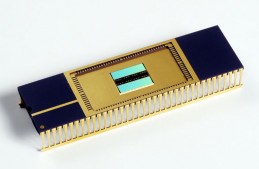Phase-change materials can fix machine memory crunch
January 31, 2012 | Source: New Scientist

Experimental phase change memory chip (credit: Samsung)
Researchers at IBM and elsewhere are exploring the idea that phase change materials (PCMs) could hold more information by switching between an amorphous state and a crystalline one.
PCM memory can write and retrieve data 100 times faster than Flash memory, which is used in many consumer gadgets and computers. It is also extremely durable and can be reused at least 10 million times; Flash can cope with just 3000 uses.
But PCM memory’s true potential lies in its ability to store more than a single bit per cell. “If you are able to control the current you can create states between the two, something that is not fully crystallized and something that is not fully amorphous,” says Evangelos Eleftheriou, head of storage technologies at IBM’s Zurich Research Laboratory in Switzerland.
Precisely how many states can be created remains to be seen, but some researchers, like David Wright at the University of Exeter in the UK, have already demonstrated 512 discrete states in a single 20-nanometre cell — about the same size as a Flash memory cell, which usually only holds two.